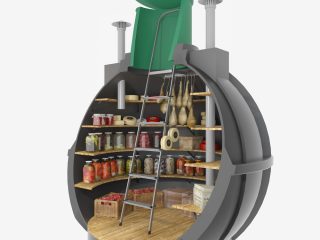Content
- 1 What is special about fermentation bedding for pigs?
- 2 Advantages of using bio-litter for pigs and piglets
- 3 Comparison of prices for bacteria for a pigsty and maintenance
- 4 Features of keeping piglets and pigs on permanent bedding
- 5 Fermentation bed life
- 6 Advantages and disadvantages of keeping pigs on deep litter
- 7 Conclusion
- 8 Reviews
Deep bedding for pigs creates comfortable living conditions for the animals. The piglet is always clean. In addition, the fermentation material generates heat, providing good warmth for the pigs in winter.
What is special about fermentation bedding for pigs?
Warm bedding for pigs works on the principle of a dry closet. Animals run across the floor, covered with a thick layer of organic matter. This could be straw, sawdust or other material. The organics contain biobacteria that process waste products of pigs. The splitting process is accompanied by the release of large amounts of heat. Due to the work of bacteria inside the pigsty, free heating is provided.
In order for bacteria for pigs to work and not die, it is important to provide favorable conditions:
- stable ventilation is installed inside the pigsty;
- the formation of drafts is unacceptable;
- You can’t lower the temperature in a pigsty below 0 OWITH;
- The litter layer must be loosened periodically with a pitchfork or rake.
The bedding will work as long as it is replenished with waste products from the pigs. They are the food for bacteria. The use of technology makes it possible to avoid constructing a permanent building for pigs. For a pigsty, you can even weld a metal frame, cover it with boards or cover it with an awning. However, a lightweight construction option is suitable for southern regions or when pigs are not expected to be kept in winter.
As reviews indicate about bedding with bacteria for pigs, for better functioning of microorganisms, it is necessary to provide the animals with the correct diet. Feed should be given half consisting of fiber so that waste products are completely fermentable.
Place bedding material for pigs on a disinfected floor. The soil under the pigsty must have good drainage properties. Pigs should not be laid on a concrete base. First, grates are placed on the floor to drain the slurry. The first layer of sawdust or straw is laid 20 cm thick. The preparation is evenly scattered on top. The organic matter is slightly tousled and the pigs are released.
Permanent bedding is laid at a temperature of 5-10 OFrom above zero. Loosening is carried out periodically so that the bacteria receive oxygen. As the layer gets wet, dry organics and the preparation are added.
The bacteria will begin to work on the third day after application.If optimal conditions are maintained, the bedding layer will last up to four years. If the pigs are absent for more than three weeks, the bacteria will die due to lack of nutrition. The thickness of bedding for pigs in a pigsty can reach from 50 to 100 cm.
Advantages of using bio-litter for pigs and piglets
According to reviews, bacteria for bedding in a pigsty have many advantages:
- by maintaining hygiene in the pigsty, the financial costs of cleaning are reduced;
- Free space heating is provided;
- there are no bad odors, dampness, dirt;
- the conditions for keeping pigs are closer to the natural environment;
- The formation of toxic ammonia fumes is minimized.
Biobacteria break down pig waste products within 24 hours.
Comparison of prices for bacteria for a pigsty and maintenance
In villages, small amounts of pig manure are dumped in heaps, and after rotting, they are sent to the garden. If you run a large farm, the waste problem increases. They will have to be taken out. In addition, hired personnel will be needed to clean the pigsty and loading work. The cost of services is high. If dry pig bedding is used, waste disposal problems are eliminated. The cost of purchasing a biological product is lower, plus sanitation is maintained in the pigsty.
The price of biological products for litter is determined taking into account a number of features:
- The number of microorganisms in 1 g of substance. The activity of the drug depends on the indicator. The more bacteria there are, the more efficiently they work in the litter.
- Consistency. The drugs are produced in granules, powder, and liquid. Some require water to start, while others activate themselves upon contact with pig excrement.
- Consumption.The more active the drug, the less it needs to be applied. For example, Biolatik, which costs 1,799 rubles, is designed for 20 m2.
- Packing. The drugs are sold in different volumes. Typically, the smaller the packaging, the higher the cost. It is more profitable to buy a large volume.
There are a large number of biological products available in stores. Popular bacteria for piglets are: “Barnyard”, “Biolatik”, “Netto-Plast”.
The video talks about the preparation for litter “LIVEBACTERIA”:
Features of keeping piglets and pigs on permanent bedding
If you decide to buy biobacteria for a pigsty, you need to take into account the peculiarities of raising animals. There are 3 forms of keeping pigs:
- pasture;
- no-walk;
- stall.
From spring to late autumn it is advisable to give preference to the pasture form. Pigs are herded. Each group is formed according to gender and age. Due to free range, there is no need for bedding.
With the onset of cold weather, they switch to a non-walking form of keeping. At this time, it is necessary to arrange bedding for the pigs and create an optimal microclimate inside the pigsty. Be sure to take care of good ventilation. For better development of the skeleton and muscle mass of pigs, a mixed form of housing is practiced. Before severe cold sets in, the pigs are released to pasture, and in the evening they are driven into the pigsty, where warm bedding awaits. The bacteria do not stop working as the pigs replenish them with new excrement.
Stall housing is practiced in private farms with a small number of livestock. Due to the limited size of the pigsty, animals cannot be separated according to age and sex. The pigs are separated in stalls.The production of offspring is regulated so that farrowing occurs closer to the beginning of the warm season.
With the appearance of offspring, the bacteria for the pigsty must work at full strength. The litter ensures cleanliness, dryness, and warmth. Good sanitation requires less use of antibacterial agents. However, small piglets are not able to produce the necessary amount of waste for bacterial activity. In a stall with young animals, the fermentation bedding is enriched with excrement taken from adult pigs.
Fermentation bed life
The manufacturer guarantees the lifespan of bacteria from 1.5 to 4 years (depending on the drug) subject to proper use. According to reviews, deep bedding for pigs often lasts one season. The short service life is associated with the peculiarities of keeping animals. For example, in the summer the herd lives outside or all the piglets are sent to slaughter, and new pigs are bred in the fall. Within three weeks, the bacteria consume the remaining excrement. If there are no new arrivals, the microorganisms die. The litter becomes unusable.
Bacteria die if there is no ventilation, the temperature regime is disturbed, and there is no drainage for liquid on the floor. It is easy to identify a non-functioning litter by its appearance. Organic matter stops absorbing liquid, and the unpleasant smell of ammonia quickly spreads throughout the room. Used material can only be recycled. Bedding waste is cleaned out of the pigsty, stored in a heap or removed.
Can it be used as fertilizer?
At the end of its service life, a large layer of waste litter remains. To remove it, you need hired equipment and people. You can reduce costs by setting up a compost heap.Completely recycled material will become an excellent fertilizer for the site in a year. Sometimes gardeners are afraid of the presence of bacteria, but they live as long as food exists. Even if you throw away the working litter, microorganisms will live in the compost heap for a maximum of 3 weeks.
Advantages and disadvantages of keeping pigs on deep litter
The use of deep litter has undeniable advantages:
- due to improved living conditions, pigs get sick less, gain weight faster, and the quality of meat improves;
- labor costs and financial costs for manure disposal are reduced;
- the release of heat by the bedding provides natural heating of the pigsty, eliminating the need for heating;
- due to the high temperature, rodents do not settle inside the litter;
- The waste material makes good compost.
The disadvantage is that over time the litter will have to be changed, and a very large layer of it accumulates over several years. Another disadvantage is the high cost of good bacteria.
Conclusion
Deep bedding for pigs creates comfort for the owners themselves. There are no bad ammonia odors spreading throughout the area. A well-kept mini-farm will not create discomfort for neighbors.














